Answered step by step
Verified Expert Solution
Question
1 Approved Answer
Round all of your answers to the nearest cent when appropriate to do so. Some questions are programmed to allow for slight variations in
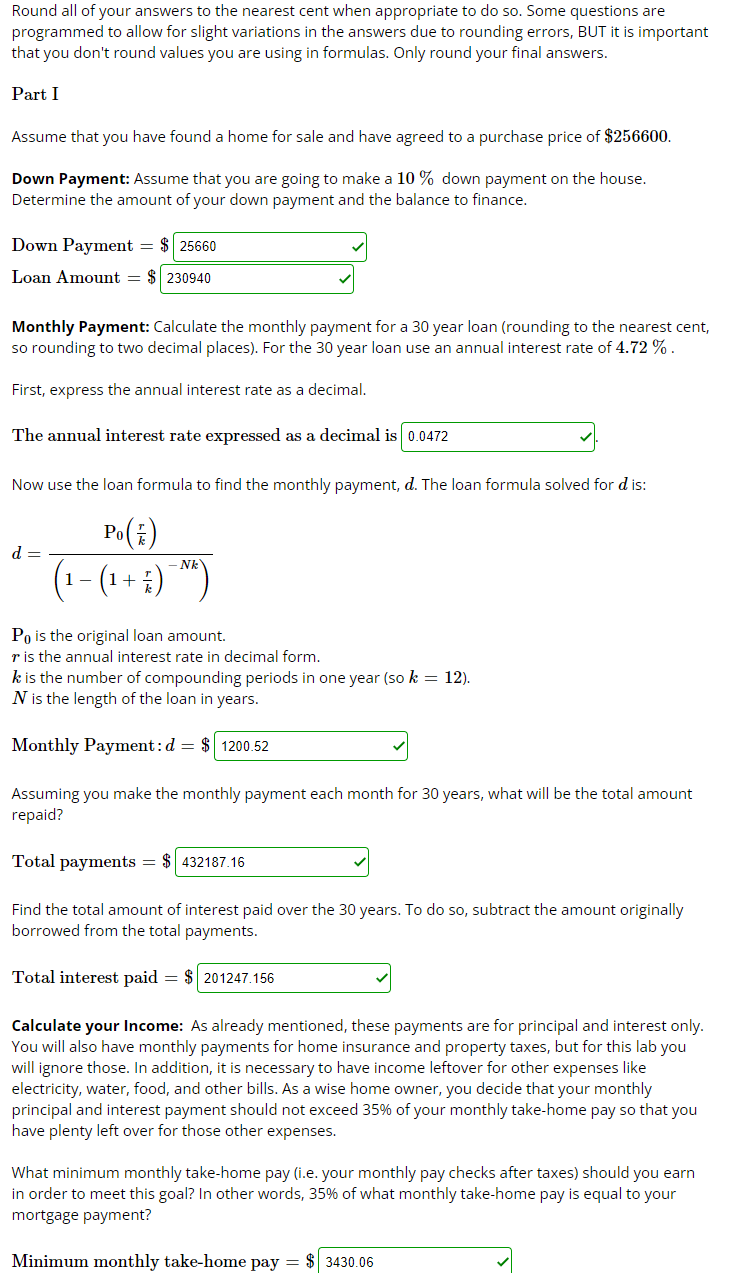
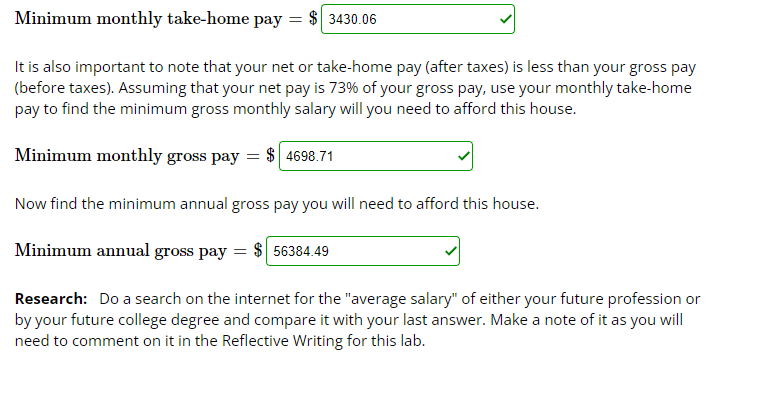
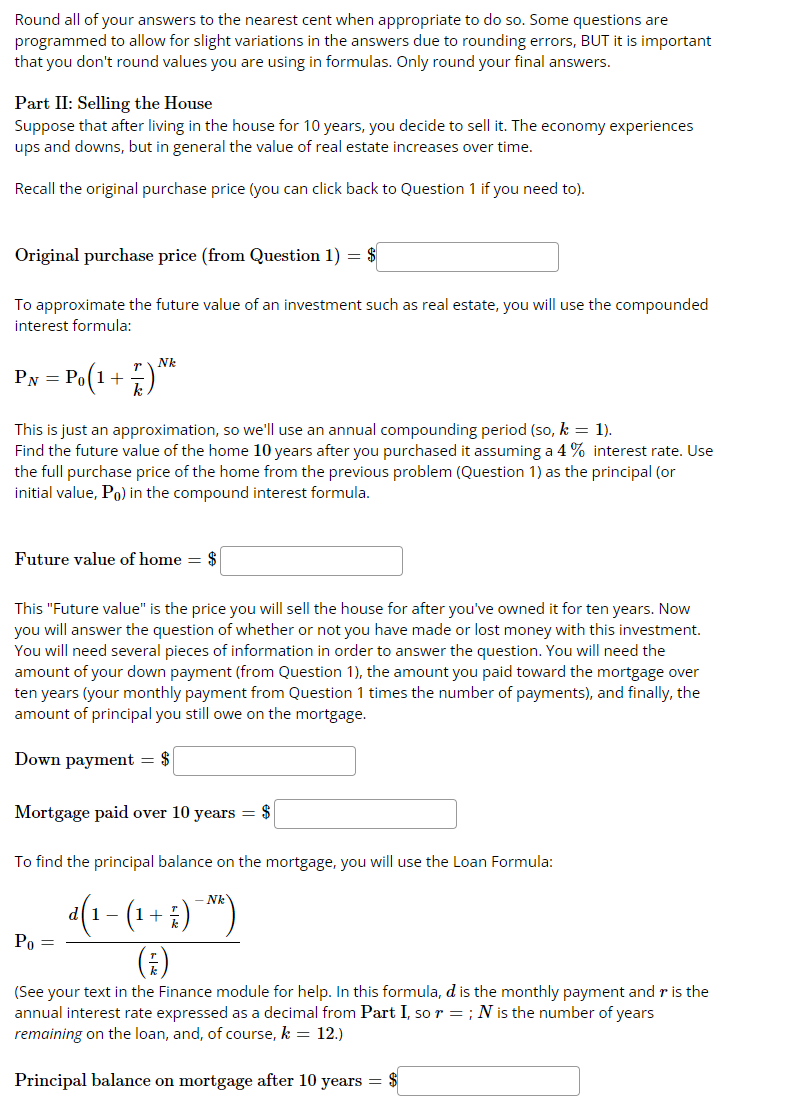
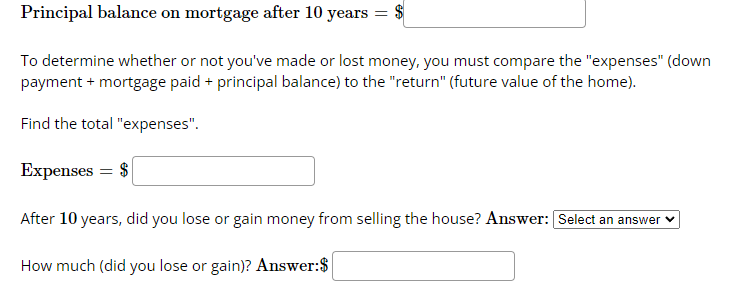
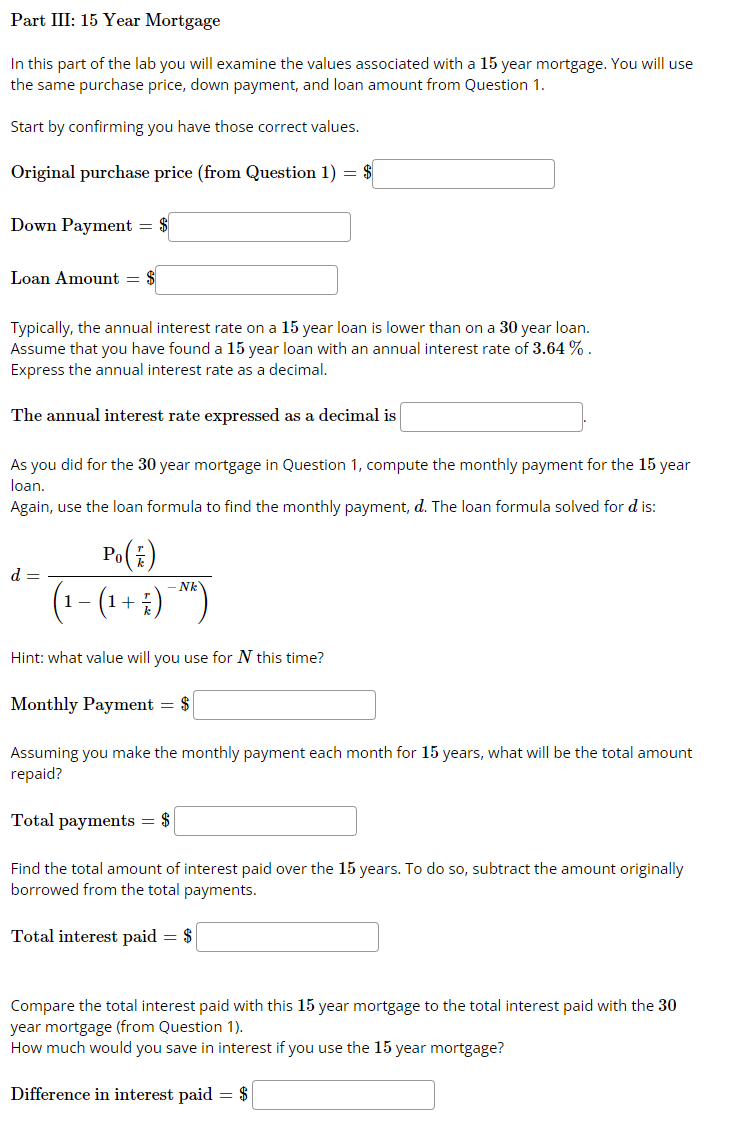
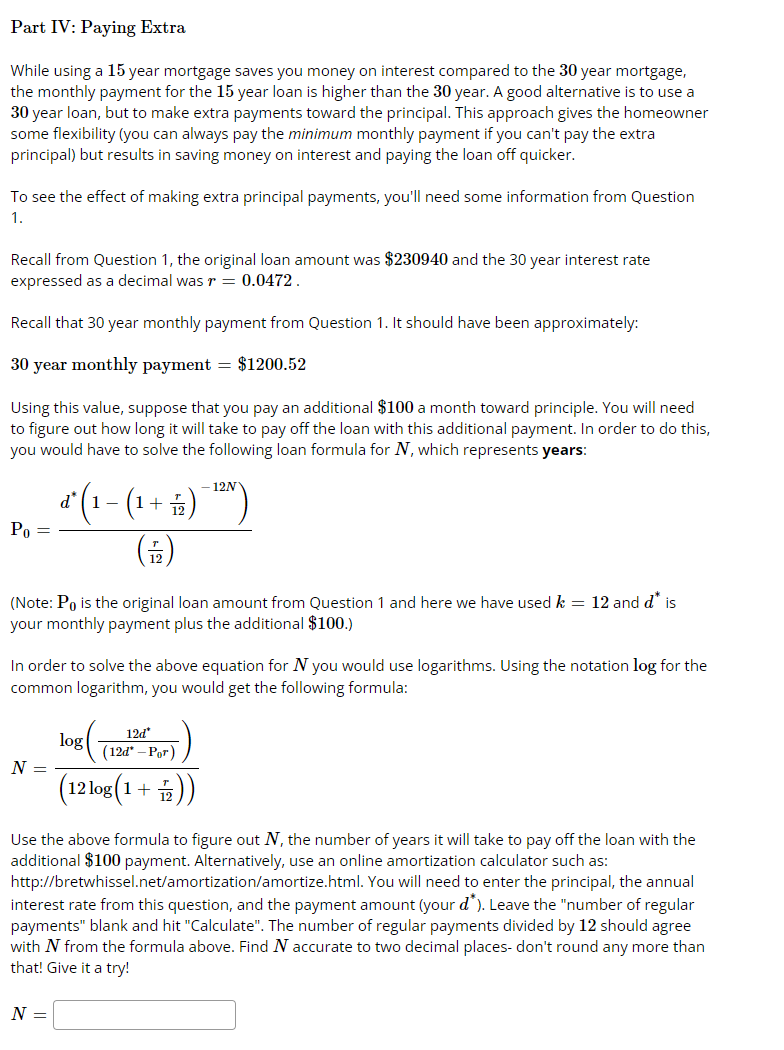
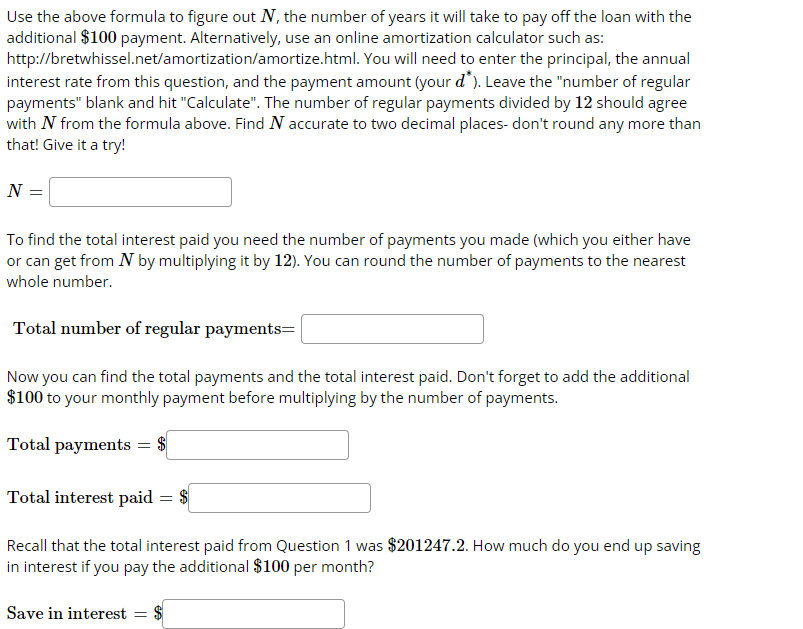
Round all of your answers to the nearest cent when appropriate to do so. Some questions are programmed to allow for slight variations in the answers due to rounding errors, BUT it is important that you don't round values you are using in formulas. Only round your final answers. Part I Assume that you have found a home for sale and have agreed to a purchase price of $256600. Down Payment: Assume that you are going to make a 10% down payment on the house. Determine the amount of your down payment and the balance to finance. Down Payment = $ 25660 Loan Amount = $ 230940 Monthly Payment: Calculate the monthly payment for a 30 year loan (rounding to the nearest cent, so rounding to two decimal places). For the 30 year loan use an annual interest rate of 4.72 %. First, express the annual interest rate as a decimal. The annual interest rate expressed as a decimal is 0.0472 Now use the loan formula to find the monthly payment, d. The loan formula solved for dis: d Po() (1-(1+)) Po is the original loan amount. r is the annual interest rate in decimal form. k is the number of compounding periods in one year (so k = 12). N is the length of the loan in years. Monthly Payment: d = $1200.52 Assuming you make the monthly payment each month for 30 years, what will be the total amount repaid? Total payments = $ 432187.16 Find the total amount of interest paid over the 30 years. To do so, subtract the amount originally borrowed from the total payments. Total interest paid = $ 201247.156 Calculate your Income: As already mentioned, these payments are for principal and interest only. You will also have monthly payments for home insurance and property taxes, but for this lab you will ignore those. In addition, it is necessary to have income leftover for other expenses like electricity, water, food, and other bills. As a wise home owner, you decide that your monthly principal and interest payment should not exceed 35% of your monthly take-home pay so that you have plenty left over for those other expenses. What minimum monthly take-home pay (i.e. your monthly pay checks after taxes) should you earn in order to meet this goal? In other words, 35% of what monthly take-home pay is equal to your mortgage payment? Minimum monthly take-home pay = $3430.06 Minimum monthly take-home pay = $3430.06 It is also important to note that your net or take-home pay (after taxes) is less than your gross pay (before taxes). Assuming that your net pay is 73% of your gross pay, use your monthly take-home pay to find the minimum gross monthly salary will you need to afford this house. Minimum monthly gross pay = $ 4698.71 Now find the minimum annual gross pay you will need to afford this house. Minimum annual gross pay = $ 56384.49 Research: Do a search on the internet for the "average salary" of either your future profession or by your future college degree and compare it with your last answer. Make a note of it as you will need to comment on it in the Reflective Writing for this lab. Round all of your answers to the nearest cent when appropriate to do so. Some questions are programmed to allow for slight variations in the answers due to rounding errors, BUT it is important that you don't round values you are using in formulas. Only round your final answers. Part II: Selling the House Suppose that after living in the house for 10 years, you decide to sell it. The economy experiences ups and downs, but in general the value of real estate increases over time. Recall the original purchase price (you can click back to Question 1 if you need to). Original purchase price (from Question 1) = $ To approximate the future value of an investment such as real estate, you will use the compounded interest formula: Nk PN = Po(1 + Po(1+) This is just an approximation, so we'll use an annual compounding period (so, k = 1). Find the future value of the home 10 years after you purchased it assuming a 4% interest rate. Use the full purchase price of the home from the previous problem (Question 1) as the principal (or initial value, Po) in the compound interest formula. Future value of home = $ This "Future value" is the price you will sell the house for after you've owned it for ten years. Now you will answer the question of whether or not you have made or lost money with this investment. You will need several pieces of information in order to answer the question. You will need the amount of your down payment (from Question 1), the amount you paid toward the mortgage over ten years (your monthly payment from Question 1 times the number of payments), and finally, the amount of principal you still owe on the mortgage. Down payment = $ Mortgage paid over 10 years = $ To find the principal balance on the mortgage, you will use the Loan Formula: Po= = - d(1 (1 + ) (1+)*) () (See your text in the Finance module for help. In this formula, d is the monthly payment and r is the annual interest rate expressed as a decimal from Part I, so r = ; N is the number of years remaining on the loan, and, of course, k = 12.) Principal balance on mortgage after 10 years = $ Principal balance on mortgage after 10 years = To determine whether or not you've made or lost money, you must compare the "expenses" (down payment + mortgage paid + principal balance) to the "return" (future value of the home). Find the total "expenses". Expenses = $ After 10 years, did you lose or gain money from selling the house? Answer: Select an answer How much (did you lose or gain)? Answer:$ Part III: 15 Year Mortgage In this part of the lab you will examine the values associated with a 15 year mortgage. You will use the same purchase price, down payment, and loan amount from Question 1. Start by confirming you have those correct values. Original purchase price (from Question 1) = $ Down Payment = $ Loan Amount $ Typically, the annual interest rate on a 15 year loan is lower than on a 30 year loan. Assume that you have found a 15 year loan with an annual interest rate of 3.64%. Express the annual interest rate as a decimal. The annual interest rate expressed as a decimal is As you did for the 30 year mortgage in Question 1, compute the monthly payment for the 15 year loan. Again, use the loan formula to find the monthly payment, d. The loan formula solved for d is: d = 1 Po W(S) - (1 + 2)-N) Hint: what value will you use for N this time? Monthly Payment = $ Assuming you make the monthly payment each month for 15 years, what will be the total amount repaid? Total payments = $ Find the total amount of interest paid over the 15 years. To do so, subtract the amount originally borrowed from the total payments. Total interest paid = $ Compare the total interest paid with this 15 year mortgage to the total interest paid with the 30 year mortgage (from Question 1). How much would you save in interest if you use the 15 year mortgage? Difference in interest paid = $ Part IV: Paying Extra While using a 15 year mortgage saves you money on interest compared to the 30 year mortgage, the monthly payment for the 15 year loan is higher than the 30 year. A good alternative is to use a 30 year loan, but to make extra payments toward the principal. This approach gives the homeowner some flexibility (you can always pay the minimum monthly payment if you can't pay the extra principal) but results in saving money on interest and paying the loan off quicker. To see the effect of making extra principal payments, you'll need some information from Question 1. Recall from Question 1, the original loan amount was $230940 and the 30 year interest rate expressed as a decimal was r = 0.0472. Recall that 30 year monthly payment from Question 1. It should have been approximately: 30 year monthly payment = $1200.52 Using this value, suppose that you pay an additional $100 a month toward principle. You will need to figure out how long it will take to pay off the loan with this additional payment. In order to do this, you would have to solve the following loan formula for N, which represents years: = 2(3-(0-1)) d + 12 (Note: Po is the original loan amount from Question 1 and here we have used k = 12 and d* is your monthly payment plus the additional $100.) In order to solve the above equation for N you would use logarithms. Using the notation log for the common logarithm, you would get the following formula: N = log 12d* (12d* -Por) (12 log(1+)) Use the above formula to figure out N, the number of years it will take to pay off the loan with the additional $100 payment. Alternatively, use an online amortization calculator such as: http://bretwhissel.net/amortization/amortize.html. You will need to enter the principal, the annual interest rate from this question, and the payment amount (your d*). Leave the "number of regular payments" blank and hit "Calculate". The number of regular payments divided by 12 should agree with N from the formula above. Find N accurate to two decimal places- don't round any more than that! Give it a try! N = Use the above formula to figure out N, the number of years it will take to pay off the loan with the additional $100 payment. Alternatively, use an online amortization calculator such as: http://bretwhissel.net/amortization/amortize.html. You will need to enter the principal, the annual interest rate from this question, and the payment amount (your d*). Leave the "number of regular payments" blank and hit "Calculate". The number of regular payments divided by 12 should agree with N from the formula above. Find N accurate to two decimal places- don't round any more than that! Give it a try! N = To find the total interest paid you need the number of payments you made (which you either have or can get from N by multiplying it by 12). You can round the number of payments to the nearest whole number. Total number of regular payments= Now you can find the total payments and the total interest paid. Don't forget to add the additional $100 to your monthly payment before multiplying by the number of payments. Total payments = $ Total interest paid: = $ Recall that the total interest paid from Question 1 was $201247.2. How much do you end up saving in interest if you pay the additional $100 per month? Save in interest = $
Step by Step Solution
There are 3 Steps involved in it
Step: 1

Get Instant Access to Expert-Tailored Solutions
See step-by-step solutions with expert insights and AI powered tools for academic success
Step: 2

Step: 3

Ace Your Homework with AI
Get the answers you need in no time with our AI-driven, step-by-step assistance
Get Started


